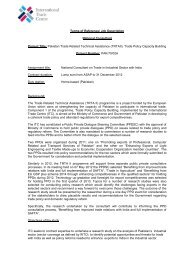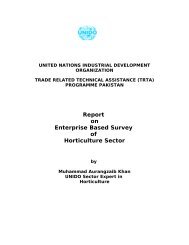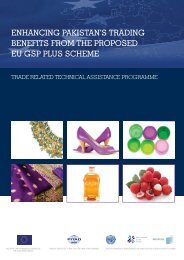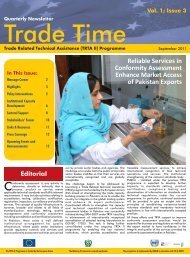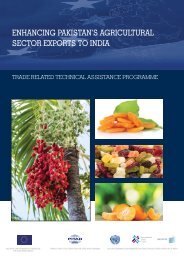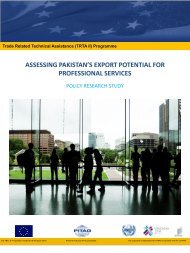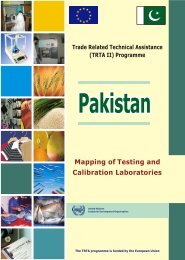Enhancing dairy sector export competitiveness - International Trade ...
Enhancing dairy sector export competitiveness - International Trade ...
Enhancing dairy sector export competitiveness - International Trade ...
You also want an ePaper? Increase the reach of your titles
YUMPU automatically turns print PDFs into web optimized ePapers that Google loves.
ENHANCING DAIRY SECTOR EXPORT COMPETITIVENESS IN PAKISTANTable 6: Annual Yield Comparison of South Asian Milk-Producing CountriesAnnual yield/animal (tonnes)BuffaloYear Pakistan Sri Lanka India Bangladesh Nepal2003 0.750403 0.089286 0.48999 0.025882 0.2161462004 0.75451 0.083333 0.511417 0.025882 0.2177222005 0.755894 0.086667 0.527024 0.025882 0.2181372006 0.744014 0.087097 0.558704 0.025882 0.2190482007 0.787546 0.087097 0.577102 0.025882 0.213303Average 0.758473 0.086051 0.532848 0.025882 0.758473CowYear Pakistan Sri Lanka India Bangladesh Nepal2003 0.365236 0.111864 0.188843 0.032245 0.0519422004 0.364282 0.115517 0.204055 0.032389 0.0528742005 0.365289 0.115254 0.21982 0.32369 0.054222006 0.368627 0.114876 0.229435 0.032351 0.0552007 0.371622 0.117213 0.236955 0.032332 0.05483Average 0.367012 0.114945 0.215821 0.032337 0.053773Source: Food and Agriculture Organization of the United Nations (FAO) , 2011Feed and NutritionLow productivity per milch animal is mainly due to limited availability of high quality fodder and sufficientquantity of water. Milk productivity levels naturally rise up to three times in the months of November andDecember due to the availability of a high nutritious forage called Berseem. 41 Furthermore, there is lack ofawareness in the farmers’ community on feed control and balanced diet which is required to maintainhealth and desirable yield levels. The dietary decisions are taken on the basis of decades of old traditionalpractices particularly in the rural areas. The animals are fed with the fodder that grows as an agricultureresidue and with other crops that are not preferred for human consumption.A decrease in the cultivable land each year due to insufficient supply of water and shrinking resources inthe farm community have led to limited availability of appropriate fodder for the milch animals. This hasalso resulted in an increase in the prices of appropriate feed which mostly remain out of the affordabilitylimits of farmers, mainly in the rural areas. The situation gets worse during the peak summer and winterseasons (May, June, December and January are the harvesting months for wheat and cotton mainly) whenthe supply of animal feed shrinks and becomes expensive at the same time.Insufficient Veterinary ServicesMajor diseases in the farm animals are the Foot and Mouth Disease (FMD), Hemorrhagic Septicemia (HS),and Mastitis in large ruminants. In small ruminants, diseases such as Entero Toximia, Caprine PleuroPneumonia and Peste des Petits Ruminants (PPR) is common. 42 These need to be treated through theavailable veterinary institutions located in most parts of the country.After the devolution of powers under the 18 th constitutional amendment, the responsibilities relating toproviding veterinary services are now assigned to the provinces. Under the new scenario, the federalgovernment is responsible for planning and implementing of the national policies, coordination withprovincial, national and international agencies on matters relating to research and development, <strong>sector</strong>aland trade development, standardization and compliance, quarantine and foreign assistance programmes41 A leguminous, winter fodder crop that is high in essential nutrients and provides easy and suitable digestibility to the livestock42 FAO Pakistan, 201034



